School Of Management
-
- American Society of Civil Engineers: Not Just a Tough Grader Marine News, Sep 2017 #18
Within the U.S. inland waterways industry, any mention of the American Society of Civil Engineers (ASCE) will almost certainly be in reference to the “Infrastructure Report Card” that ASCE prepares and issues every four years, describing the condition and performance of America’s infrastructure in 16 categories: aviation, bridges, dams, drinking water, energy, hazardous waste, inland waterways, levees, ports, public parks, rail, roads, schools, solid waste, transit and waste water. It is a major effort, with many ASCE members investing a great deal of time and hard work in collecting and analyzing data and then putting it all together in a format that is both informative and easily understandable. The end results are presented in the form of letter grades as on a familiar school report card.Inland Report CardIt has typically not been a pretty picture, and this year’s Report Card was no exception. Most infrastructure categories in this year’s Report Card received grades of D or D+. A few categories received grades of C+. The nation’s rail infrastructure was at the head of the class with a grade of B. ASCE is not at much risk of being accused of grade inflation.
The inland waterways infrastructure was among those categories receiving a grade of D. Sadly, this was actually good news, since the last Report Card four years ago gave the inland waterways infrastructure a grade of D–. The low grade given to the inland waterways infrastructure in the ASCE Report Card is based primarily on the aging and unreliable system of locks and dams on the inland waterways and on the need for increased and more consistent funding to rehabilitate existing locks and dams and to construct new and larger locks to handle modern tow sizes. The low grade in the ASCE Report Card, and the factors on which it is based, is frequently cited in testimony before Congress, on editorial pages, in the trade press, and in presentations by industry members to anyone who will listen, as evidence of the urgent need for more attention and funding to be given to the inland waterways infrastructure.More than GradesBut ASCE is a society of engineers, and engineers are not content to simply point out a problem and then wait for others to do something about it. Their DNA requires that, when faced with a problem, they will attempt to solve it. While the gloomy conclusions of the ASCE Report Card are well known, what is not nearly so well known is what ASCE is doing to address the problems. With regard to the nation’s waterways, in 2000 ASCE created the Coasts, Oceans, Ports, and Rivers Institute (COPRI). As stated on its website, COPRI serves both its membership and society at large “by uniting the disciplines working to sustainably develop, protect and restore coasts, oceans, ports, waterways, rivers and wetlands; integrating the key stakeholders into decision making processes; advancing technological state of art and practice; and influencing public policy.”This lofty goal is implemented on a practical level by several committees within COPRI, one of which is the Waterways Committee, which in turn has a Subcommittee dedicated to “Alternative Financing for Waterways Infrastructure.” The Subcommittee’s operating premise is that it is not realistic to rely solely on Congress for the funds necessary to raise the inland waterways infrastructure to a grade higher than D. The Subcommittee has been active, therefore, in exploring and advocating for alternative sources of funding.Among those initiatives have been several workshops conducted throughout the country during 2015 and 2016. The author spoke at one of these workshops in St. Paul, Minn. in September 2016, at which there were more than 90 attendees, representing the engineering and construction industry, the U.S. Army Corps of Engineers, waterway operators and users, financial institutions, concessionaires, Congressional staff, port authorities and other stakeholders. A follow-up workshop was held in April of this year in Oakland, Calif.After the St. Paul workshop, Roundtables on Alternative Financing were held in October and December 2016, organized by the Ash Center for Democratic Governance and Innovation at the Harvard University John F. Kennedy School of Management, in partnership with the Army Corps of Engineers and other federal agencies. Several members of the COPRI Subcommittee took part in these Roundtables. From these Roundtables, the Ash Center issued a report in January of this year, “Tapping Private Financing and Delivery to Modernize America’s Federal Water Resources.”ASCE in ActionIn June of this year, the COPRI Subcommittee organized a separate meeting with staff of the Army Corps of Engineers at its headquarters. The goals of this meeting were, first, to identify the specific statutory provisions that the Corps views as limiting its ability to use alternative approaches to financing improvements to the inland waterways infrastructure and, second, to explore with the Corps the statutory authorizations that would give the Corps more flexibility in this regard. This initiative was undertaken to take advantage of the bipartisan support that development of the nation’s water resources continues to enjoy within Congress, as evidenced by the passage of the Water Resources Reform and Development Act of 2014 and the Water Resources Development Act of 2016 included in the Water Infrastructure Improvements for the Nation (WIIN) Act. The passage of these two Acts offers hope that there will continue to be Congressional action to address the needs of waterways infrastructure every two years, with corresponding opportunities to facilitate the use of alternative financing approaches to meet those needs.The COPRI Subcommittee’s work in exploring alternative financing of waterways infrastructure through its own workshops, through the participation of its members in the Roundtables organized by the Ash Center, and through other efforts of its members, has culminated in a report prepared by a COPRI Task Committee published earlier this year, “Alternative Financing and Delivery of Waterways Infrastructure”. The Task Committee was originally established by COPRI in 2015 to evaluate the public-private partnership authorization included in the Water Resources Reform and Development Act of 2014. The scope of the final report, however, is much broader: it examines the use of alternative financing generally in support of water resources within the context of the civil works program of the Army Corps of Engineers. The report contains specific and detailed recommendations to enable the use of alternative financing methods to address the infrastructure needs highlighted in the ASCE Infrastructure Report Card. Key constraints are identified, and then specific legislative, regulatory, or administrative solutions to these constraints are offered. Precedents in support of these proposed solutions are provided, where available. To adopt a waterways metaphor, there are obstacles in the channel to be sure, but the COPRI report is a useful guide for removing them or navigating around them.Although ASCE is most often identified only with the low grade given in its Infrastructure Report when the needs of the inland waterways infrastructure are being discussed, it would be a disservice to the society and to the solution-minded engineers who are its members to overlook the many contributions that they are making – with far less fanfare – to meeting those needs.The AuthorJames A. Kearns has represented owners, operators, financial institutions and end users for more than 30 years in the purchase, construction and financing of vessels engaged in both foreign and coastwise trades of the United States. Kearns has earned an LL.M. (in Taxation) from New York University, J.D. cum laude from the University of Notre Dame, and a B.S.E.E., summa cum laude from the University of Notre Dame.(As published in the September 2017 edition of Marine News) -
- Alphabet Soup Maritime Logistics Professional, Jul/Aug 2018 #56
received his bachelor’s degree in Computer Science from The Ohio State University and a Master’s in Business Administration from the Weatherhead School of Management, Case Western Reserve University.This article first appeared in the July/August print edition of Maritime Logistics Professional magazine
-
- GASTECH '84 Maritime Reporter, Oct 15, 1984 #18
pm—Coffee break. 4:00 pm—"The West European Gas Gamble: An Oligopoly versus a Monopsony," by O. Noreng, Institute of Energy Policy, Norwegian School of Management, Bekkestua, Norway. 4:30 pm—"LNG Pricing: Past, Present, and Future," by G.D. Carameros Jr., International Gas Development Corporation
-
- The Aker Way: From Surviving to Thriving Maritime Logistics Professional, Q4 2013 #32
Wharton School and has also studied economics and mathematics at Colby College, London School of Economics, and Political Science at the Norwegian School of Management (BI). Joining Rokke is Scott Clapham, SVP Projects and Business Improvements and Jeffrey Theisen, the firm’s Chief Financial Officer. Together
-
 )
March 2024 - Marine Technology Reporter page: 45
)
March 2024 - Marine Technology Reporter page: 45ronments. The new agreement will address speci? c techni- cal gaps in the UUV defense and offshore energy markets especially for long duration, multi-payload mission opera- tions where communications are often denied or restricted. As part of the new alliance, Metron’s Resilient Mission Autonomy portfolio
-
 )
March 2024 - Marine Technology Reporter page: 25
)
March 2024 - Marine Technology Reporter page: 25, conductivity, temperature, turbidity, oxi- dation reduction and pressure with depth. Sand Reclamation Data Collected Using HMS-620 Courtesy URI Graduate School of Oceanography The USV had a custom-? tted winch for sensor dips and tows to gather water col- Falmouth Scienti¿ c, Inc. Pocasset, MA USA 02559
-
 )
March 2024 - Marine Technology Reporter page: 19
)
March 2024 - Marine Technology Reporter page: 19About the Author vey with the pipe tracker is not required, resulting in signi? - Svenn Magen Wigen is a Cathodic Protection and corrosion control cant cost savings, mainly related to vessel charter. expert having worked across The major advantage of using FiGS on any type of subsea engineering, design
-
 )
March 2024 - Marine Technology Reporter page: 15
)
March 2024 - Marine Technology Reporter page: 15sensor options for longer mission periods. About the Author For glider users working in ? sheries and conservation, Shea Quinn is the Product Line Manager the Sentinel can run several high-energy passive and active of the Slocum Glider at Teledyne Webb acoustic sensors, on-board processing, and imaging
-
 )
March 2024 - Marine Technology Reporter page: 6
)
March 2024 - Marine Technology Reporter page: 6MTR Editorial Advisors Gallaudet Hardy The Honorable Tim Gallaudet, Kevin Hardy is President PhD, Rear Admiral, U.S. of Global Ocean Design, Navy (ret) is the CEO of creating components and Ocean STL Consulting and subsystems for unmanned host of The American Blue vehicles, following a career
-
 )
April 2024 - Maritime Reporter and Engineering News page: 39
)
April 2024 - Maritime Reporter and Engineering News page: 39Tech Files Latest Products, Systems and Ship Designs “Wall Climbing Robot” Danish Pilot calls gets ClassNK Nod LEGO Model "A tribute build to a work life at sea" Image courtesy MOL, Sumitomo Heavy Industries lassNK granted its Innovation Endorse- Image courtesy Espen Andersen/DanPilot ment for
-
 )
April 2024 - Maritime Reporter and Engineering News page: 35
)
April 2024 - Maritime Reporter and Engineering News page: 35SIMULATION e have a close relationship with tech- Realism is prized beyond immersive, photo-realistic visu- nology, evidenced by, for example, als, and providers are introducing increasingly accurate func- the phones we are estimated to un- tionality. FORCE Technology’s upcoming DEN-Mark2 math- lock around
-
 )
April 2024 - Maritime Reporter and Engineering News page: 27
)
April 2024 - Maritime Reporter and Engineering News page: 27RADM PHILIP SOBECK, MILITARY SEALIFT COMMAND With COVID, we had to make some hard choices for our Do your CIVMARs have upward mobility? mariners because we couldn’t rotate. Many of our mariners The Navy has Sailors who become “Mustangs,” and work found other employment, and were able to use their skills
-
 )
April 2024 - Maritime Reporter and Engineering News page: 25
)
April 2024 - Maritime Reporter and Engineering News page: 25mariners, but we need to attract the junior people ners (CIVMARs). now, those third-class mariners with the certi? cations they get from school, and start building our workforce from within. We’re hearing a lot about “contested logistics.” We need to both recruit and retain today, in order
-
 )
April 2024 - Maritime Reporter and Engineering News page: 14
)
April 2024 - Maritime Reporter and Engineering News page: 14Book Review Approach to Meeting Underwater Radiated Noise Limits Def ned By Raymond Fischer uantitative underwater radiated noise limits will construction inspections, 5) possible training with respect to be developed shortly by IMO, and/or countries salient design/construction essentials, 6) compliance
-
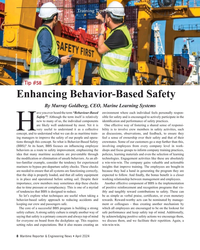 )
April 2024 - Maritime Reporter and Engineering News page: 8
)
April 2024 - Maritime Reporter and Engineering News page: 8Training Tips for Ships © By tuastockphoto/AdobeStock Tip #58 Enhancing Behavior-Based Safety By Murray Goldberg, CEO, Marine Learning Systems ave you ever heard the term “Behaviour-Based environment where each individual feels personally respon- Safety”? Although the term itself is relatively sible for
-
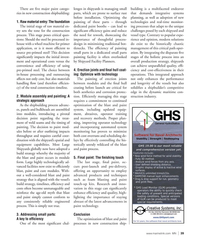 )
April 2024 - Marine News page: 39
)
April 2024 - Marine News page: 39There are ? ve major paint catego- lenges in shipyards is managing small building is a multifaceted endeavor ries in new construction shipbuilding: parts, which are prone to surface rust that demands integrative systems before installation. Optimizing the planning, as well as adoption of new 1.
-
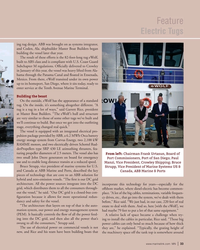 )
April 2024 - Marine News page: 33
)
April 2024 - Marine News page: 33Feature Electric Tugs ing tug design. ABB was brought on as systems integrator, and Coden, Ala. shipbuilder Master Boat Builders began building the vessel later that year. The result of these efforts is the 82-foot-long tug eWolf, built to ABS class and is compliant with U.S. Coast Guard Subchapter M
-
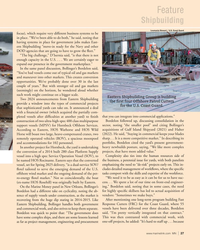 )
April 2024 - Marine News page: 27
)
April 2024 - Marine News page: 27Feature Shipbuilding Loumania Stewart / U.S. Coast Guard focus), which require very different business systems to be in place. “We’ve been able to do both,” he said, noting that having systems in place for government jobs makes East- ern Shipbuilding “move-in ready for the Navy and other DOD agencies
-
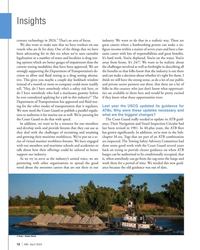 )
April 2024 - Marine News page: 12
)
April 2024 - Marine News page: 12ries of virtual mariner workforce forums. We have engaged are inspected. The Towing Safety Advisory Committee had with our members and maritime schools and academies to done some good work with the Coast Guard several years talk about how their offerings could be tailored to better back on trying
-
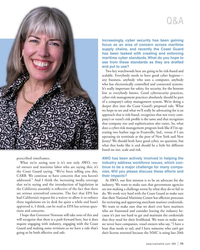 )
April 2024 - Marine News page: 11
)
April 2024 - Marine News page: 11Q&A Increasingly, cyber security has been gaining focus as an area of concern across maritime supply chains, and recently the Coast Guard has been tasked with creating and enforcing maritime cyber standards. What do you hope to see from these standards as they are drafted and put to use? Two key
-
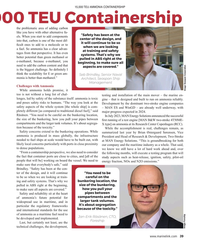 )
February 2024 - Maritime Reporter and Engineering News page: 39
)
February 2024 - Maritime Reporter and Engineering News page: 3915,000 TEU AMMONIA CONTAINERSHIP 000 TEU Containership the problematic area of adding carbon like you have with other alternative fu- “Safety has been at the els. When you start to add components center of the design, and into that, carbon is one of the most dif- it will continue to be so ? cult ones
-
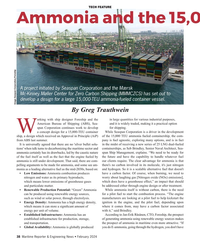 )
February 2024 - Maritime Reporter and Engineering News page: 38
)
February 2024 - Maritime Reporter and Engineering News page: 38TECH FEATURE Ammonia and the 15,00 A project initiated by Seaspan Corporation and the Mærsk Mc-Kinney Møller Center for Zero Carbon Shipping (MMMCZCS) has set out to develop a design for a large 15,000-TEU ammonia-fueled container vessel. Image Seaspan Corporation/Foreship By Greg Trauthwein orking with
-
 )
February 2024 - Maritime Reporter and Engineering News page: 36
)
February 2024 - Maritime Reporter and Engineering News page: 36HYBRID 2-stroke controllable pitch propeller PTO powertrain Source: MAN Energy Solutions how the system is intended to operate, says Oskar Levander, VP Strategy & Business Development, Kongsberg Maritime. For example, a primary shaft-driven PTO rotates whenever the engine is running; a secondary one
-
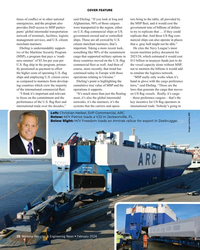 )
February 2024 - Maritime Reporter and Engineering News page: 28
)
February 2024 - Maritime Reporter and Engineering News page: 28COVER FEATURE times of con? ict or in other national said Ebeling. “If you look at Iraq and tors bring to the table, all provided by emergencies, and the program also Afghanistan, 98% of those cargoes the MSP ? eet, and it would cost the provides DoD access to MSP partici- were transported to the
-
 )
February 2024 - Maritime Reporter and Engineering News page: 22
)
February 2024 - Maritime Reporter and Engineering News page: 22powering and FDL Locomotive Modernization programs. From there, I customers in the work boat sectors, including dredging, river decided to go back to school and get my MBA from Gannon tugs, harbor tugs, ATBs, ferries, and medium-size cruise ships. University here in Erie. Leveraging that growth opportunity
-
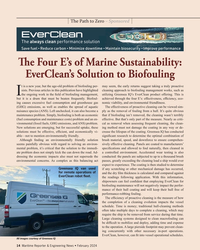 )
February 2024 - Maritime Reporter and Engineering News page: 14
)
February 2024 - Maritime Reporter and Engineering News page: 14The Path to Zero – Sponsored EverClean The always clean performance solution • • • • Save fuel Reduce carbon Minimize downtime Maintain biosecurity Improve performance T e Four E’s of Marine Sustainability: EverClean’s Solution to Biofouling t is a new year, but the age-old problem of biofouling per-
-
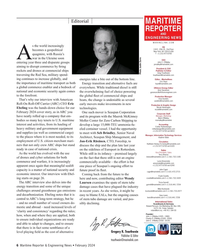 )
February 2024 - Maritime Reporter and Engineering News page: 6
)
February 2024 - Maritime Reporter and Engineering News page: 6Editorial MARITIME REPORTER AND ENGINEERING NEWS M A R I N E L I N K . C O M s the world increasingly HQ 118 E. 25th St., 2nd Floor becomes a geopolitical New York, NY 10010 USA T +1.212.477.6700 quagmire, with Russia’s Awar in the Ukraine soon CEO John C. O’Malley entering year three and disparate
-
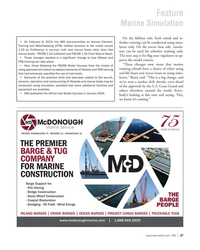 )
February 2024 - Marine News page: 37
)
February 2024 - Marine News page: 37courses. FRB training can take place. “These changes now mean that marine • Now, those following the PSCRB Model Courses have the choice of training schools have a choice of either using using approved simulators to replace elements of lifeboat and FRB training real-life boats and rescue boats or using
